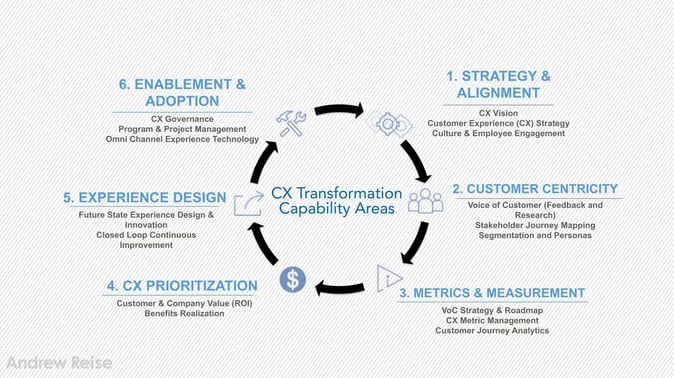Customer experience is an enterprise effort. A customer experience program sets the strategy and underpins its importance so that employees are empowered to deliver on brand promises during customer interactions.
Implementing a successful customer experience program involves seven essential elements that, when executed correctly, create a flywheel you can apply to any vertical in your organization.
The 7 Elements of a Customer Experience Program

1. Vision and Alignment
Vision is the North Star aligning brand promise, customer experience, and organizational objectives. This clarity and alignment connect CX project teams to the company’s broader initiatives.
Almost immediately, any customer experience efforts become linked to the strategic direction of the company. Because this may be difficult, some organizations develop customer promise statements to make the vision come alive, aligning and empowering employees and partners to deliver. In other words, your vision must become part of the DNA of your corporate culture.
2. Strategy
Your strategy is most effectively communicated through a roadmap that includes a realistic list of initiatives that align with your vision. You might define some quick hits that can be implemented, for example, in 90 days with immediately noticeable impacts. Other initiatives, such as addressing foundational capabilities, will be longer term.
However, all efforts must provide value for both the company and your customer—just like the goal itself. Value identification can come through alignment of strategic efforts, such as customer retention versus customer acquisition. The narrowing of this focus provides clarity to all stakeholders and is reflected in the roadmap.
3. Customer Centricity
Because customers are at the center of your vision and strategy, their input is imperative. The voice of the customer is discovered through surveys, industry and market research, interaction analytics, and other methodologies. Soliciting the feedback of customers yields a treasure trove of their wants, needs, and preferences. You must understand what is most important to your customers, what drives them to buy from you instead of your competition, and what keeps them coming back.
Mapping the current state of your customer lifecycle highlights critical moments across their journey. Furthermore, journey mapping uncovers customer pain points and opportunities to mitigate them for an improved experience.
An outstanding customer experience, either from the quality of your products or the customer service you provide (or both), drives brand loyalty. Acknowledging the voice of the customer allows you to segment and identify your ideal customer in order to meet their needs with more personalized products and services.
4. Metrics and Measurement
In order to keep a continuous pulse on the experience and measure improvements, you must establish CX and operational metrics across the customer journey. You could choose benchmarks, such as:
- Changes in customer attrition rates
- Increases in net promoter scores
- Digital customers conversion metrics
The natural extension of any measurement efforts is ensuring a closed-loop process in which actions are taken to resolve issues identified by the underlying measures.
Metrics and measurement tools also help you discover what customers think about your business. This reinforces customer centricity, giving you more data to map the customer journey and drive strategy.
5. Customer Experience Prioritization
After you’ve defined your vision, listened to customers, mapped their journey, and established metrics and measurement, you need to sequence your initiatives. Prioritize the top five or 10 that are measurable and can drive the most value for your customers (e.g., shorter wait/service times), deliver the most value to your company (e.g., increased retention), and produce a clear path to ROI (e.g., benefits outweigh cost) that can be measured.
Also, consider how easy it is for individuals and teams to implement the chosen initiative. Quick wins are important to prove value and secure buy-in for tackling future challenges.
6. Experience Design
An important part of any CX program is the ability to make dramatic improvements to the customer’s experience. Often, this originates with future state design and is tremendously powerful—and energizes the CX team. Although any blue-sky ideation is helpful, future state design must be grounded in customer insights.
Future state design can start with challenging the current state and designing experiences that are more authentic. Or, ideation sessions can be focused on customer personas to ensure experiences are meeting those needs. Ultimately, the future state ideation session reinvents the experience in a meaningful manner not often derived by continuous improvement efforts.
7. Enablement and Adoption
Successful governance of your customer experience program comes down to consistent leadership and managing organizational adoption. You must be laser-focused to stay the course and give your people sure footing to see their part through.
Most customer experience program solutions incorporate omnichannel technology to achieve the CX vision. This technology might include a new customer relationship management solution, journey analytics and orchestration, digital personalization, a contact center suite, artificial intelligence, and more.
It makes sense to work with a partner that has a deep well of experience and proven methodologies to help guide and manage your CX program. Andrew Reise provides full project oversight, project management, and transparency into the process, thus helping you progress toward achieving your objective. If you’re ready to make your customer experience your obsession, request a consultation with one of our experts.



